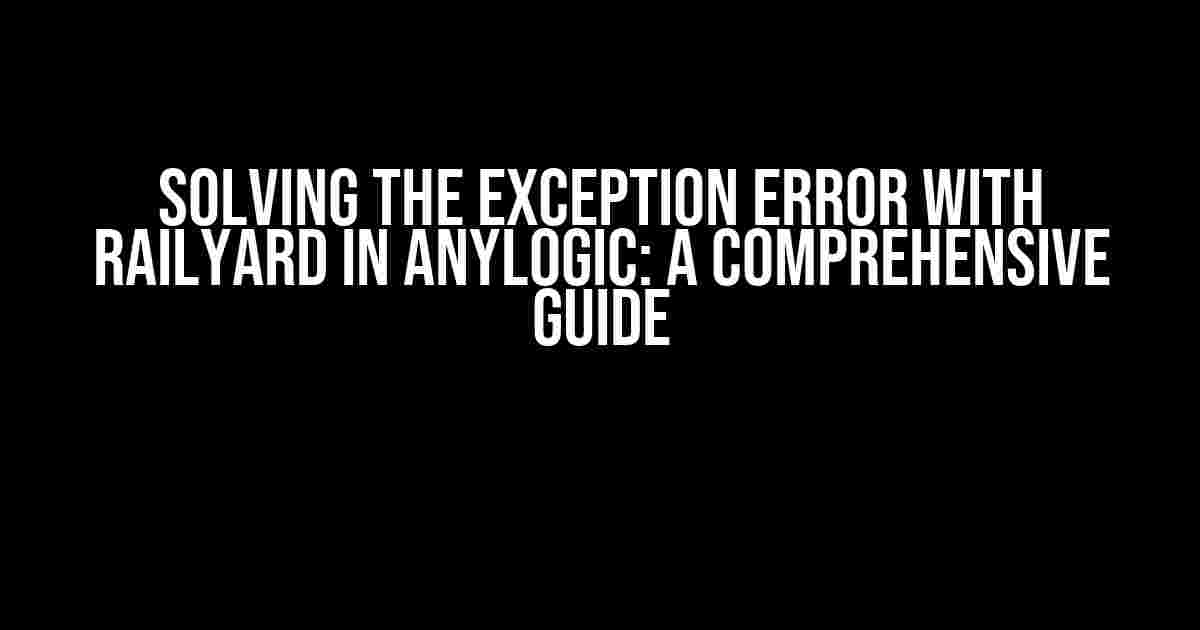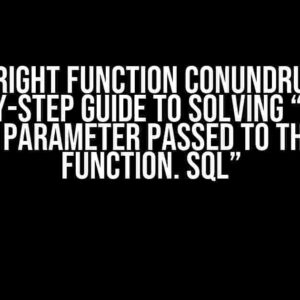Are you tired of encountering exception errors with RailYard in AnyLogic? Do you find yourself stuck in a never-ending loop of frustration, trying to resolve the issue but to no avail? Fear not, dear modeler, for we’ve got you covered! In this article, we’ll delve into the world of RailYard and AnyLogic, exploring the common causes of exception errors and providing you with step-by-step solutions to overcome them.
What is RailYard in AnyLogic?
RailYard is a built-in library in AnyLogic that allows modelers to create complex rail networks and simulate rail operations. It provides a range of features and tools to design, optimize, and analyze rail systems, making it an essential component of many transportation and logistics models.
Why do Exception Errors Occur with RailYard in AnyLogic?
Exception errors with RailYard in AnyLogic can occur due to a variety of reasons, including:
- Incorrectly configured rail networks
- Invalid or missing data inputs
- Insufficient computational resources
- Buggy or outdated RailYard libraries
- Incompatible model versions
In the following sections, we’ll explore each of these causes in depth and provide solutions to overcome them.
Solution 1: Check and Configure Your Rail Network
A common cause of exception errors with RailYard is an incorrectly configured rail network. To resolve this issue, follow these steps:
- Open your AnyLogic model and navigate to the RailYard library.
- Select the rail network component and check its properties.
- Verify that the network is correctly configured, paying attention to:
- Node and link connections
- Direction and orientation of tracks
- Signal and switch settings
- Make adjustments to the network as needed, ensuring that it accurately represents the real-world rail system.
// Example code to configure a rail network in AnyLogic
RailNetwork railNetwork = new RailNetwork();
railNetwork.addNode(new RailNode("Node 1", 0, 0));
railNetwork.addNode(new RailNode("Node 2", 10, 0));
railNetwork.addLink(new RailLink("Link 1", railNetwork.getNode("Node 1"), railNetwork.getNode("Node 2")));
Solution 2: Verify and Validate Your Data Inputs
Invalid or missing data inputs can also cause exception errors with RailYard. To resolve this issue, follow these steps:
- Review your data inputs, ensuring that they are accurate and complete.
- Check for any null or missing values, and replace them with default or estimated values as needed.
- Verify that data formats and units are consistent throughout the model.
- Use data validation tools in AnyLogic to detect and correct errors.
| Data Input | Example Value | Validated Value |
|---|---|---|
| Train speed (km/h) | invalid | 60 |
| Track capacity (trains/hour) | null | 10 |
| Station coordinates (latitude, longitude) | (0, 0) | (40.7128, -74.0060) |
Solution 3: Optimize Your Model’s Computational Resources
If your model is computationally intensive, it may cause exception errors with RailYard. To resolve this issue, follow these steps:
- Review your model’s computational requirements, identifying any bottlenecks or inefficiencies.
- Optimize your model’s performance by:
- Reducing the simulation time step
- Decreasing the number of agents or entities
- Implementing parallel processing or distributed computing
- Monitor your model’s performance, adjusting the computational resources as needed.
// Example code to optimize a model's computational resources in AnyLogic
getExperiment().setMaxTimeStep(1.0);
getExperiment().setParallelProcessing(true);
Solution 4: Update Your RailYard Libraries
Outdated or buggy RailYard libraries can cause exception errors. To resolve this issue, follow these steps:
- Check the AnyLogic website for the latest RailYard library updates.
- Download and install the latest version of the RailYard library.
- Update your model to use the latest RailYard library version.
// Example code to update a RailYard library in AnyLogic
RailYardLibrary railYardLibrary = new RailYardLibrary("RailYard 2.0");
getExperiment().setRailYardLibrary(railYardLibrary);
Solution 5: Check Model Compatibility
Incompatible model versions can also cause exception errors with RailYard. To resolve this issue, follow these steps:
- Check the AnyLogic website for compatible model versions.
- Verify that your model is compatible with the latest RailYard library version.
- Update your model to a compatible version, if necessary.
| Model Version | RailYard Library Version | Compatibility |
|---|---|---|
| AnyLogic 8.7 | RailYard 1.5 | Compatible |
| AnyLogic 9.0 | RailYard 2.0 | Compatible |
| AnyLogic 8.5 | RailYard 2.0 | Incompatible |
Conclusion
In this comprehensive guide, we’ve explored the common causes of exception errors with RailYard in AnyLogic and provided step-by-step solutions to overcome them. By following these instructions and explanations, you’ll be able to resolve exception errors and optimize your rail network simulations. Remember to always verify and validate your data inputs, optimize your model’s computational resources, update your RailYard libraries, and ensure model compatibility. Happy modeling!
If you have any further questions or concerns, please don’t hesitate to reach out to our community of experts and modelers. Together, we can create a world of exceptional rail network simulations!
Frequently Asked Question
Stuck with RailYard in AnyLogic? Don’t worry, we’ve got you covered! Here are some frequently asked questions to help you troubleshoot those pesky exception errors:
Why do I get an exception error when I try to run my RailYard model in AnyLogic?
This error often occurs when there’s an issue with the model’s configuration or setup. Check that you’ve correctly defined the rail network, trains, and schedules. Also, ensure that your model is correctly scaled and that there are no overlapping tracks or conflicting movements.
How do I troubleshoot an “Error in agent initialization” exception in RailYard?
This error usually indicates a problem with an agent’s parameters or properties. Review your agent’s settings, paying attention to the initial values and formulas used. Also, check for any circular dependencies or infinite loops that might be causing the issue.
What does the “Cannot schedule event” exception in RailYard mean, and how do I fix it?
This error typically indicates a scheduling conflict or mismatch. Verify that your event schedules are correctly defined and don’t overlap. Also, check that your trains’ routes and schedules are consistent with the rail network’s layout and capacity.
Why do I get a “Null pointer exception” when trying to access a RailYard block’s properties?
This error usually means that the block you’re trying to access hasn’t been properly initialized or doesn’t exist. Double-check that the block is correctly placed and configured in your model, and that you’re using the correct references and variables.
How do I debug an “Uncaught exception” error in RailYard, especially when it doesn’t provide any additional information?
When faced with a cryptic error message, try to isolate the issue by commenting out recent changes or simplifying your model. You can also use AnyLogic’s built-in debugging tools, such as the Model Debugger or the Console, to gather more information and identify the root cause of the problem.



